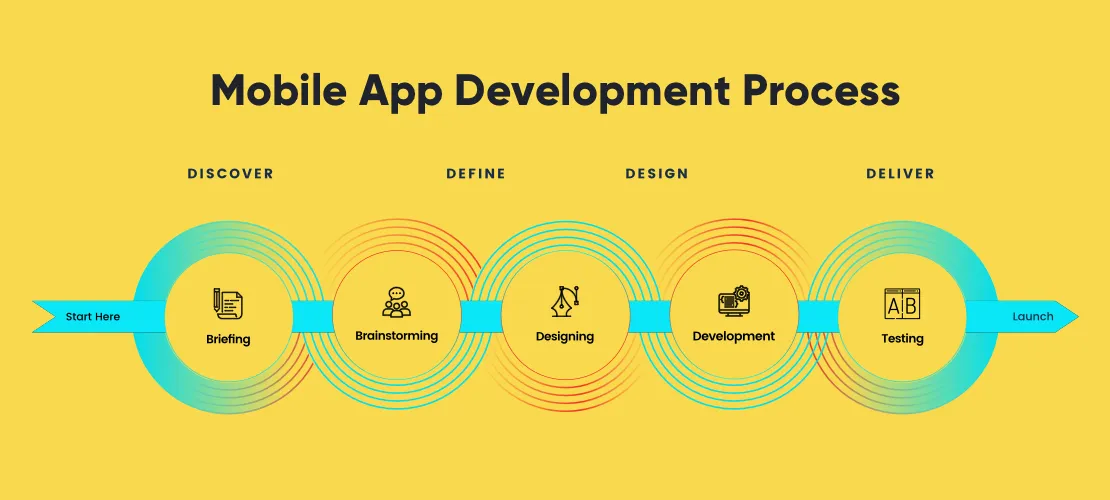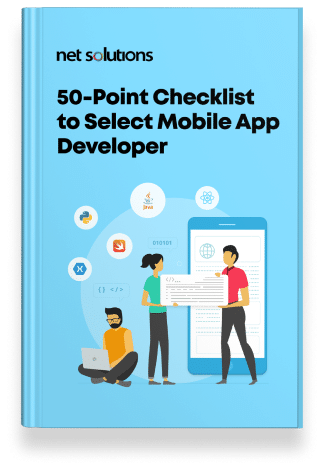

The mobile app development market is growing massively. In this digital transformation dedicated era, investing in a mobile app is a golden opportunity for businesses. In the third quarter of 2021, users downloaded 27.6 billion apps from Google Play and 8.1 billion downloads happened on the Apple App Store. Although the competition is high for a new entrant, not supporting a mobile app could be a big mistake given that most of the world’s population is already preferring mobile apps as their favorite touchpoint.
According to another study by eMarketer, the average time spent on the app is significantly higher than the time spent on the web browser.

This guide is for businesses who are planning to launch a mobile app but are concerned about getting started. It will cover everything a business needs to know about mobile app development from the ground up.
Mobile app development is designing and building software applications that can run on a mobile device. Typically, a mobile app makes use of a network connection to work with remote computing resources. Thus, the mobile app development process involves building installable software bundles, implementing backend services such as data access with an API, and testing the application on target devices.
The mobile app development process is similar to the software development process, which includes:

Nowadays, there is an app for everything! According to App Annie’s State of Mobile report, the mobile app sector has witnessed tremendous growth.

If a business has an operating website and not a mobile app, they are missing out on growing their audience and revenues that would follow.
The advantages of mobile app development include:
Before investing in a mobile app, a business must decide the approach they will follow to build an app. The most commonly known approaches include — native apps, cross-platform apps, hybrid apps, progressive web apps, and rapid mobile app development.
Here’s an overview of each of them:
1. Native App
A native app is a platform-specific app that is capable of running only on a particular operating system. In other words, the business would have to develop apps differently for iOS and Android (i.e., to launch an app on both platforms, it will have to be coded twice).
Building a native application is expensive (for obvious reasons). However, the app is often better in performance and offers a good user experience.
Example: Spotify
2. Cross-Platform App
In Cross Platform App Development the app is coded once and is compatible to run on multiple platforms. In other words, there is a single, unified code that works for both Android and iOS apps.
Cross-platform apps are cheaper to build owing to its platform independent attribute.
Example: Alaska Airlines
3. Hybrid App
A hybrid app is a blend of a native mobile app and a web app. In technical terms, a web application put into a native shell is a hybrid app. These apps are built in a native container but, when downloaded, they showcase content similar to that of a web app.
These apps are easier and faster to develop but might lead to performance issues.
Example: Evernote
4. Progressive Web App
A progressive web app (PWA) is a web application that offers a native app-like user experience. The best part is that a PWA runs on the web, which implies that the user does not need to install a separate app for it. The upshot of PWAs are that they consume less data, perform better, and increase engagement rates.
Example: Twitter Lite
Here is a comparison chart to help make an informed decision when it comes to choosing a mobile app development approach:
A mobile app development framework is a software framework that provides a platform to develop mobile applications. It provides the foundation and the structure to build scalable mobile apps.
The top five frameworks that are widely being used for creating an app include:
Created by: Facebook
App Examples:
Created by: Google
App Examples:
Reflectly, Google Ads
Created by: Drifty Co.
App Examples:
Instant Pot, MarketWatch
Created by: Microsoft
App Examples:
Azure, Alaska Airlines
Created by: Adobe
App Examples:
Wikipedia, Health Tap
Choosing the right mobile app development framework can be confusing. Here is a resource to help make an informed decision:

We respect your privacy. Your information is safe.
Before moving on with the development process, the first step is to finalize the software development methodology.
Keeping up with the current trends and the need to facilitate faster releases, choosing the Agile development methodology is a safe bet. The incremental and iterative nature of the Agile methodology makes it easy for the development team to work on the existing and the new requirements.
The Agile development process is illustrated below:

Coming back to the mobile app development process, let’s discuss the eight-step process that a business will need to follow to develop, launch, and maintain the mobile app. You should also go through our mobile app development checklist to ensure you don’t miss out on anything while building your app.
1. Come up with a Mobile App Idea
According to Statista, there are approximately 3.48 million apps on Google Play Store and 2.22 million apps on Apple Store. These numbers are continuously growing.

Taking the growing number of apps into consideration, developing an idea for a mobile app must be a thoughtful process. The more unique the idea, the better the chances are for surpassing competition in the market.
The selected idea should solve a user problem and have a high value proposition. Here are some top mobile app development ideas for 2024:

2. Requirements Analysis
After developing an idea for a mobile app, the next step is to gather all of the app requirements around that idea. This part will help answer:
To make an informed decision around the requirements analysis, it is advised to run various brainstorming sessions along with target audience surveys.
3. Finalize the Mobile App Development Tech Stack
This step includes decision-making around two critical factors:
Mobile App Development Approach — Will it be a native app, a hybrid app, a cross-platform app, or a progressive web app?
Mobile App Development Framework — What framework will be used to develop the mobile app?
4. Create Mobile App Prototype and Wireframe
A prototype is a draft version of the mobile app that helps demonstrate its UI/UX flow. This step helps in validating the app idea, its UI/UX, and also helps attract seed funding.
There are a couple of app prototyping tools to choose from, including:
To get a better insight into other mobile app prototyping tools along with the respective pricing, visit here.
5. Build a Minimum Viable Product (MVP)
Building a Minimum Viable Product (MVP) is the next step in line. An MVP is a basic, launchable version of the app. Further changes to the app will depend on the feedback from the end-users. The MVP also helps in validating the product-market fit (whether the app solves the problems it aims to address and is helpful to the users).
The steps for building the mobile app MVP include:
6. Mobile App Testing
At this stage, the mobile app is tested for its functionality, existing bugs (if any), and usability. The different types of mobile app testing include:
Functional Testing: Helps validate the proper functionality of the app
Interruption Testing: Used to check the interruption level in the app’s functionality due to incoming calls, low or no internet connectivity, etc.
Memory Testing: Helps check the memory that the mobile application occupies
Installation Testing: Helps to check how much time it takes to download the application from the respective app store
Performance Testing: Helps to check how well the app performs in the best and worst-case scenarios
Similar to prototyping tools, mobile app testing tools can be leveraged to automate the testing process. This, in turn, helps to ensure faster time to market. Some of the best tools for mobile app testing include:
G2 Rating: 4.3/5
G2 rating — 4.5/5
G2 Rating — 4.4/5
G2 Rating — 4.4/5
G2 Rating — 4.2/5
7. Launch Mobile App and Work on App Store Optimization
Whether it is the MVP or the fully-fledged app, the launch is an essential stage where the app is made available for download. At this stage, a prepared marketing plan coinciding with app launch will help to accelerate downloads.
Another important task at this stage is to work on the app store optimization (ASO). ASO is a process to enhance the app’s visibility, which, in turn, helps improve download rates.
Here are seven app store optimization strategies to consider:
8. Maintain and Update Frequently
Building and launching an app is not enough! The app will require maintenance and updating such as identifying and fixing bugs, introducing patches, and integrating new features based on the latest mobile app trends.
Here are some tried and tested mobile app development tips to successfully engage, acquire, and retain users with high-quality mobile apps.
In today’s ever-evolving and dynamic world, merely having a mobile presence is not enough.
The popular apps that shined in 2023 might not possess the same potential for success in 2024. Simply implementing the correct mobile application development strategy will also not ensure success. To be successful, the business will need to incorporate the latest mobile application development trends into their strategy.
To outsmart competitors in the mobile app development industry, it is critical to analyze the mobile app development trends that are ruling the industry. Some of which include:
If the business does not have an in-house mobile app consulting team, it is a good strategy to choose mobile app development vendor who’s experienced and knows their work well.
Here are some factors to consider when on a mission to find a mobile app development company:
For a comprehensive list of considerations, here’s a resource to help choose the best mobile app developer:

We respect your privacy. Your information is safe.
Failure + Solutions
The mobile industry is rapidly progressing to an interminable extent. Today, the app stores are jam-packed with a myriad of mobile applications that strive to attract user attention. This sheer volume creates fierce competition for businesses who want to develop mobile apps to drive their business and can lead to increased chances of mobile app failure.
The following section mentions the causes of mobile app failure and the commonly made mistakes during the mobile app development process:
1. There is no product-market fit
The app fails to solve a real-world problem or serve the needs of the target audience.
Solution: Conduct extensive market research to identify the user needs before moving to finalize the app idea.
2. Ranks low on User Discoverability
According to App Annie, 37% of the surveyed app users found an app through a family member or a friend. The lower the emphasis on the app discoverability metrics, the lower the probability of app success.
Solution: Focus on metrics that enhance the ASO (app store optimization) of the app.
3. Too Many/Too Few Features
If the mobile app features are too many or too few, it is unlikely that the app will attract attention. Where too many are overwhelming for a user, too few can lead to low engagement rates.
Solution: Implement the MoScow rule of prioritization during requirements analysis. The business will have to segment the features based on must-haves, should-haves, can-haves, and won’t-haves in the process.
4. High Complexity
If the app has too many features or a clumsy user interface (UI), it will be directly ignored by the users.
Solution: The major area that needs to be worked on is UX/UI. When a prototype is created, run it across the team and work on the valuable feedback. The goal of the app should be to promote intuitiveness and responsiveness.
Also, follow a mobile-first design approach as most people are smartphones these days, and you must focus on catering to their needs first.
5. Slow Updates
Relying on longer app update cycles makes losing out to a competitor more likely. Fast shipping is a prominent app success metric for any business and, if they fail to deliver value over time, people will prefer uninstalling the app.
Solution: Introduce DevOps in the mobile app development process for automating CI & CD pipeline.
If the business model revolves around mobile apps and the business is looking forward to experimenting with a new, disruptive technology, creating a proof of concept (PoC) is essential. A PoC is a way to validate the technical feasibility of a new idea.
Creating a PoC should be the first step in the mobile app development process because, if the app idea is not technically feasible in the first place, there is no use in spending time and other resources on building it.
According to App Annie, $73 billion USD in investments poured into mobile companies, thus showcasing a 27% growth year-over-year.
Businesses are investing massively in developing a mobile app. The approximate mobile app development cost depends on the business model, app type, framework used, technologies used, approach used, and outsourced company location.
However, a ballpark figure for mobile app development, according to a Clutch survey, reports an average cost of $171,450, with an extensive range from under $30K to over $700K.
Firebase is Google’s open-source mobile platform used to develop high-quality mobile applications. It falls under the “Backend-as-a-service” (BaaS) model. In this model, the mobile app developers only have to work on the frontend, while the backend processes are outsourced to a third-party BaaS vendor.
The choice of programming languages for mobile development depends on the mobile app development platform (i.e., whether the app is being built for Android, iOS, or web app).
Some of the must-have features for a mobile app include:
Some of the best strategies to convert a mobile app into a profitable business include:
An Integrated Development Environment (IDE) is a platform that supports all the tools and resources required to build a mobile application on a single, unified platform. The top five IDE’s for mobile app development include:
Developers with minimal coding skills can develop mobile applications using graphical user interface drag-and-drop features. The best platforms for low-code or no-code app development include Appy Pie, GoodBarber, BuildFire, AppSheet, and Microsoft PowerApps.
According to Grandview Research, the global mobile application market size is expected to grow at a compound annual growth rate (CAGR) of 11.5% from 2020 to 2027. This growth suggests now is the best opportunity for businesses to develop and launch a mobile app.
In this comprehensive write-up, everything about mobile app development was addressed to help businesses take advantage of this lucrative industry. No matter the industry, having a mobile app creates a competitive advantage.

Amit Manchanda is a seasoned Project Lead with a passion for technology and a knack for delivering successful software projects. With expertise in ASP, Adobe Flex, and Android development, he has established himself as a proficient developer and leader in the industry.
When he's not immersed in coding or leading development teams, Amit indulges in his love for cricket. He finds solace in watching cricket. The game is a source of inspiration for his work, reminding him of the importance of strategy, adaptability, and teamwork.
Net Solutions is a strategic design & build consultancy that unites creative design thinking with agile software development under one expert roof. Founded in 2000, we create award-winning transformative digital products & platforms for startups and enterprises worldwide.